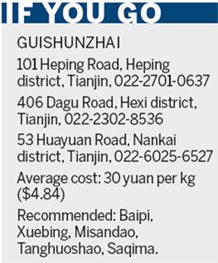![Guishunzhai delicacies and Chinese longjing green tea can be combined for a pleasant afternoon tea break. [Photo by Wang Yuke / China Daily] Guishunzhai delicacies and Chinese longjing green tea can be combined for a pleasant afternoon tea break. [Photo by Wang Yuke / China Daily]](U491P886T1D60107F12DT20130422160341.jpg)
Guishunzhai delicacies and Chinese longjing green tea can be combined for a pleasant afternoon tea break. [Photo by Wang Yuke / China Daily]

If your craving for fancy desserts is fading after too many pretty Western pastries, try revitalizing your taste buds with the Tianjin Hui ethnic specialty branded under the name Guishunzhai. While Western pastries may blend butter, cream, cheese, cinnamon and more, Guishunzhai simply employs earthy, grass-roots ingredients: sesame oil, ground white sugar, as well as dates, haw, raisin and flower petals among the flour.
The two humble staples, sesame oil and ground white sugar, reflect both the Hui ethnic people's appetite and their Muslim dietary requirements.
As pastry brands such as Fozoon, Bread Talk and Paris Baguette have become popular in stores, Guishunzhai exists in relative obscurity, for migrants and expats in particular in Tianjin.
The time-honored brand, boasting 80 years of tradition, never takes a short cut in ingredient selection and manufacturing.
If Guishunzhai is new to you, the pungent sesame oil smell and somewhat exotic flavor may be jarring at first, but it's easy to acquire a taste for the ethnic delicacy.
Here are some recommendations from Tianjin locals.
Baipi ("white skin"): A very traditional Guishunzhai
As its name implies, Baipi has a milky colored (but tasteless) skin. On its one flat surface, Chinese characters carrying auspicious meaning are exquisitely inked in red.
One note of caution: Hold or bite the nugget with care or you might disgrace yourself - the sheet like flakes of pastry fall off vigorously.
But as you sink your teeth into the core, a dollop of sweet stuffing tucked away comes as a pleasant surprise. Optional flavors range from mashed dates, red beans and salty nuts to rose and hawthorn.
Dates are peeled and perfectly mashed so that the grainy flesh is hardly noticed. What you get is a thick, silky texture and an aura of dates that overwhelms your mouth and nose.
Misandao ("honey three cuts"): A timeless offering
It is a golden-brown irregular square coated with glistening syrup ("mi"), while three knife cuts point to "san dao".
Sticky syrup makes the clusters seem to cuddle together. Prying neighbors apart produces thready candy-floss.
In contrast to its crusty exterior, the inside is soft, fluffy and a bit moist. Its texture is similar to a muffin's, but far removed in flavor. Sesame oil dribbles out, while its intoxicating aroma consumes your senses.
Xuebing ("snowy cookie"): Sweet Tooth's Beloved
Studded with white-sugar grains, the beautiful cake's name evokes a snow-capped mountain. The exterior's crunch nicely contrasts with the mashed inner stuffing, a bonus for any voracious "sweet tooth".
Maqiu, fangsu, tanghuoshao, meiguigao and saqima are also hailed as classic temptations that Tianjin folks never tire of eating.
Nibbling at Guishunzhai delicacies of your choice while lingering over Chinese longjing green tea promises to be an unwinding and refueling afternoon tea break.

Copyright ©1999-2011 Chinanews.com. All rights reserved.
Reproduction in whole or in part without permission is prohibited.